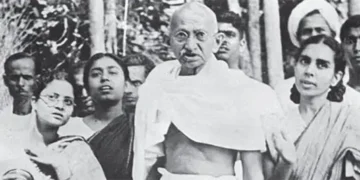 THE World Yoga Day celebrated every year on June 21 betokens some rudimentary knowledge about what yoga is all about. In the Indic knowledge system, the eight limbs of yoga (Ashtanga Yoga) – as mentioned in Patanjali’s Yogsutras – are ‘yamas’ or five social observances: non-violence, truthfulness, non-stealing, chastity and non-possessiveness; ‘niyamas’ or five moral observances: purity, contentment, self-discipline, self-study, devotion or surrender; ‘asanas’ (yoga postures); ‘pranayama’(breathing techniques for controlling ‘prana’, the vital life force); ‘pratyahara’ (withdrawal of senses); ‘dharana’ (concentration); ‘dhyana’ (meditation); and ‘samadhi’ (enlightenment, nirvana, self-realisation etc).
THE World Yoga Day celebrated every year on June 21 betokens some rudimentary knowledge about what yoga is all about. In the Indic knowledge system, the eight limbs of yoga (Ashtanga Yoga) – as mentioned in Patanjali’s Yogsutras – are ‘yamas’ or five social observances: non-violence, truthfulness, non-stealing, chastity and non-possessiveness; ‘niyamas’ or five moral observances: purity, contentment, self-discipline, self-study, devotion or surrender; ‘asanas’ (yoga postures); ‘pranayama’(breathing techniques for controlling ‘prana’, the vital life force); ‘pratyahara’ (withdrawal of senses); ‘dharana’ (concentration); ‘dhyana’ (meditation); and ‘samadhi’ (enlightenment, nirvana, self-realisation etc).
These eight limbs of yoga offer a systematic approach to calming the mind and finding liberation from suffering. The final three stages, ‘dharana’, ‘dhyana’ and ‘samadhi’ are collectively referred to as Samyama (integration) as they are inextricably linked. As such, concentration (dharana) and meditation (dhyana) practices are the paths ultimately leading to ‘samadhi.’
These practices are not evaluative processes, but rather states of mind in complete absorption. ‘Samadhi’ is said to be an equanimous state of mind in which the practitioner is no longer able to perceive the act of meditation or have a separate sense of self from it. In releasing the self from ego and illusion of separation, ‘samadhi’ is undisturbed by emotions of desire and anger and connects practitioners to their true self as one with universal consciousness.
Bliss, enlightenment
The term ‘samadhi’ is derived from Sanskrit roots, ‘sam’ meaning ‘together’, ‘a’ meaning ‘toward’, and ‘dhe’ meaning ‘put’. Direct translations vary from bliss to liberation and even enlightenment. In Hinduism, Buddhism and Jainism, ‘samadhi’ is regarded as the pinnacle of all spiritual and intellectual activity, in addition to it being a precondition for attaining release from the cycle of death and rebirth. In tantric literature, ‘samadhi’ is considered the result of the union of Siva and Sakti at the seventh ‘chakra’ (plexus) called Sahasrara (the thousand-petalled lotus on top of the head) in the Kundalini system (of seven ascending chakras).
Mandukya Upanishad mentions that the yogi in ‘samadhi’ remains in turiya or fourth state of consciousness where duality does not exist. The other three states are jagrat (waking), svapna (dreaming) and susupti (deep sleep). The yogi sees oneness in all objects and dualities, not differentiating between man and woman, heat and cold, rope and snake. When the yogi resurfaces into waking consciousness, dualities come to exist. This experience of unity consciousness is a state of enlightenment where the mask of illusion creating separation and fragmentation is pierced. Behind appearance of separation is a unified field of wholeness where seer and scenery are one.
J Krishnamurti, the renowned 20th Century philosopher, recounts the nature of religious experience in ‘samadhi’: “…What took place was beyond all words and description. It was the centre of all creation…a purifying seriousness that cleansed the brain of every thought and feeling; its seriousness was as lightning which destroys and burns up; the profundity of it was not measurable, it was there immovable, impenetrable, a solidity that was as light as the heavens…
“…There was only seeing, the eyes that saw beyond time-space…Of a sudden, that unknowable immensity was there, not only in the room and beyond but…in the innermost recesses, which was once the mind, it was there, clear, strong, impenetrable and unapproachable whose intensity was fire which left no ash. With it was bliss…” Krishnamurti hints at the brain’s part in this: “The brain had lost all its impulses; it was only an instrument of observation, it was seeing, not as the brain belonging to a particular person but a brain which is not conditioned by time-space.”
































